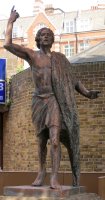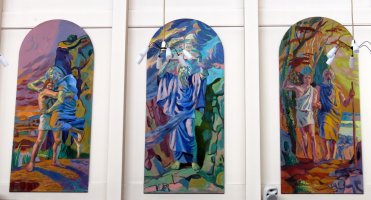Hans Feibusch (1898-1998)
St John, sculpture by Feibusch.
Hans Feibusch finds a place on this site due to his many mural works in churches, and his small number of sculptural works also associated with churches. Though his oeuvre is later than most of the artists noted on this website, he continued the long tradition of figural work.
Hans Feibusch, a German-born painter and later sculptor, was of Jewish origin, and left Germany in 1933 to settle in Britain. By then he was a well established painter, having studied originally in Munich and then Berlin, travelling in Italy in the early 19220s, then Paris for a year, and then from 1925 being a member of the Frankfurt Artists' Association, exhibiting primarily in that city and in Berlin. When he came to England, he quickly was elected a member of the London Group of painters, in 1934. His first church mural was a one-off in the former Methodist Chapel, Collier's Wood, London, but the breakthrough in his art came in 1940 when he met the Bishop of Chichester, George Bell, who had seen the Methodist Chapel piece (Christ washing the feet of the disciples). He was commissioned to make murals for various churches in the diocese and, as his reputation as a mural painter spread, elsewhere across the country, over 30 in all, sometimes a single piece, sometimes several works. He also painted some secular murals, notably for the Civic Centre in Newport, Gwent, and for the Town Hall in Dudley. He also wrote on the subject, with a book on mural painting in 1946, and a variety of articles.
His sculptural work is not prolific: he started working in the medium aged over 70, after cataract operations made it difficult for him to paint for a period. In the modern fashion, his pieces are typically bronzed resin, cast from the original sculpture modelled in clay. He has several portrait busts, a mix of weirdly modern and more traditional styles, and a small number of maquettes of figure subjects. However his public sculpture is scant. In London he has two I am aware of. The larger one is a statue of St John the Baptist standing outside St John's Wood Church, close to where he lived, modern and with the emphasis on the pose and movement of the figure rather than the fine detail and surface. And there is a half-figure of Christ raised from the dead, arms outstretched, in St Alban the Martyr Church in Holborn: the building, designed by the architect William Butterfield no less, was burnt out in World War II, and Feibusch also painted a very large mural there, called The Trinity in Glory (1966). Outside of London, the best place to see his sculpture is in Chichester Cathedral itself, and his mural work can be seen there too.
Mural works by Feibusch.
His murals are of far more interest than his sculpture in my view; his early masters when he was starting out as a young, impressionable painter worked in the genres of Expressionism and Cubism, and this comes out greatly in the bold colours and treatment of light in his murals. Not since Frank Brangwyn in a previous generation was there a muralist in Britain with such prominence: Feibusch was an infant at the time Brangwyn started painting murals, and by the time Feibusch arrived in England, Brangwyn's best works were pretty well over and done with. Among Feibusch's work in London, a particularly splendid group of half a dozen are on long term loan to the German Church of St Bonifatius, Aldgate East (see picture above).
Visits to this page: 1,103 since 8 February 2025

